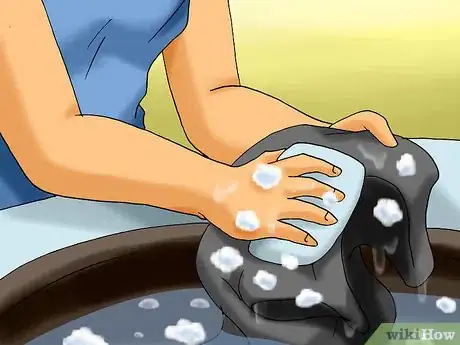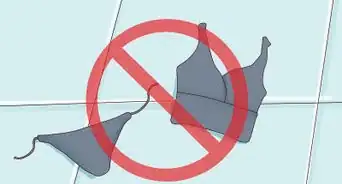This article was co-authored by Robert Shapiro. Robert Shapiro is a Laundry Specialist and the General Manager at Milt & Edie's Drycleaners & Tailoring Center in Burbank, California. With more than a decade of experience, he specializes in dry cleaning, stain removal, tailoring, alterations, and green and eco-friendly cleaning processes. Robert has also been featured in publications such as Cleaner and Launderer Magazine.
There are 13 references cited in this article, which can be found at the bottom of the page.
This article has been viewed 58,474 times.
Many people do not realize swimwear benefits from specialized treatment. Furthermore, it’s common for people to overlook or simply disregard the washing and care instructions found on the inside tags. This almost always leads to the wearer’s disappointment and/or dissatisfaction. Regardless of how much you paid for your swimsuit, taking care of your swimwear the right way will leave you with clean, colorful, beautiful swimwear for years to come.
Steps
Caring for Swimwear during Use
-
1Avoid chlorine. Chlorine is a caustic element in bleach that kills germs but can cause colours to fade in certain fabrics and damages threads. Although pool water has less chlorine than laundry bleach, it will still wear away at the integrity of your suit.
- If you have a home pool, brush up on proper management. The Centers for Disease Control recommend a concentration of at least 1 ppm in pools and 3 ppm in hot tubs at a 7.2 - 7.8 pH with constant cleaning. Not only does this keep your swimwear healthy, but it keeps you healthy as well.[1]
- In someone else’s pool, you may ask the host or hotel staff questions about upkeep, such as chlorine level measurements. Different factors affect the level, and improper treatment can mean more wear and tear on your swimwear.
- Search for alternatives. Your neighborhood may have non-chlorinated pools, or you can choose to treat your own pool with an alternative such as saline. On vacation, choose the ocean or other water sources.[2]
-
2Steer clear of rough surfaces. As with any clothing, rough or jagged edges snag and abrade. Be aware of where you sit, lean, or lay, as it is easy to forget that these surfaces are rubbing up against the fabric, harming the once smooth and luxurious texture you purchased.Advertisement
-
3Avoid getting excess lotions and oils on your swimwear. Sunscreen, tanning oils, and cosmetics are harmful to delicate material. Exposure causes discoloration and damage. These products are at odds with the synthetic material in swimsuits and leave stains that grow over time and break down the fabric.[5]
- Mineral-based lotions and oil formulations are said to be particularly adept at causing yellowing and gradual stains.[6]
- Treat stains as you would body oil by rinsing immediately, then cleaning with either vinegar or detergent mixed in a bath of cold water for 30 minutes.
- If possible, put on lotion or sunscreen before you put your swimsuit on. Wait a few minutes for it to dry.
Cleaning Swimwear after Use
-
1Rinse your swimwear in cold water after each wear. Most people wash their swimsuits themselves.[7] Even in a pinch, a rinse is better than nothing. It serves to wash away harmful chemicals such as chlorine, oils, and even bacteria before it can embed deeper into the fabric. You can even take it into a cold shower.[8]
- Before this, avoid wrapping the swimsuit in a towel. The towel holds in the moisture and chemicals. A towel wet with pool water will contribute chlorine and other substances that wear out swimwear.
- Alternatively, you can give it to the dry cleaners. They use fabric softeners and wash the swimsuits in a less abrasive way.[9]
-
2Hand wash your swimwear. Electric machines are easy, but even a gentle cycle uses heat and tumbling. This will wear out the material, causing a loss of integrity, shape, padding, and delicate embellishments.
- After rinsing immediately after usage, throw the used swimwear into a sink full of cold water for at least five minutes with a neutral detergent. Usually, washing swimsuits does not cause shrinkage or color loss.[10] But leaving it in too long will allow the water to work its way into the fibers, damaging the fit, so don’t get distracted.
- Use a mild soap for delicate fabrics. Regular detergent is too harsh and contributes to deterioration and fading. Avoid bleach and moisturizers.
- Men’s trunks are the exception in that they contain less spandex. This makes them better able to withstand the trauma of a machine wash cycle. You may still choose to wash them more gently by hand, though.[11]
-
3Treat stains directly with spot cleaner. Alternatively, use baking soda for two hours before washing or with vinegar by soaking the swimwear in one part white vinegar to three parts water for 30 minutes. This can also be used before wear to prevent color bleeding.[12]
-
4Gently squeeze out the water. Like washing, machine drying is too rough for fragile swimwear and will ruin the shape. Instead, roll up the swimsuit to coax out most of the water.
- Be gentle and don’t wring it out. It may be tempting, but the twisting motion is still damaging.
-
5Lay the swimsuit out to dry. Do this in a shaded and well-ventilated area. This prevents water from pooling and stretching fibers. It also reduces wrinkles and creases.
- Never leave the swimsuit exposed to direct sunlight. The heat will cause the same color damage you tried to avoid earlier. Cool air from an open window or a blow dryer, if in a hurry, are safer options.[13]
Storing Swimwear
-
1Store the swimsuit at room temperature. After it has dried out in the open, store the swimsuit in a temperature-controlled room away from disruptions such as a leaking pipe, a heater, or an open garage door. This will ensure that heat and cold do not expand and contract the material and that sunlight doesn’t cause fading.[14]
-
2Avoid plastic bags and similar restrictive spaces. If there is any moisture in the swimwear or in the area, it can get in, damage the material, and cause mildew.
- When storing dry swimwear that will be used soon, place it flat on a shelf or in a dry container such as a plastic storage bin. Choose the location with the fewest temperature fluctuations, heat exposure, and pet or child threat, such as under the bed.
- For longer storage, swimwear can be placed in a garment bag. This can be vacuum-sealed for added protection.
-
3Rotate suits. Keep one or two extras on hand so that you can give the one you wore previously a 24-hour break. This allows the fabric to settle back into place, preserving elasticity.[15]
- Keep an extra on hand for hot tubs. The high heat and chlorine level will do extra damage, so a cheap spare will come in handy.
Community Q&A
-
QuestionCan I iron a bathing suit if it's wrinkled?
 TheunknowndoorCommunity AnswerNo. Bathing suits are almost always made of synthetic materials like polyester, nylon, polypropylene, Lycra, or spandex. These materials have low melting point and will burn if you put an iron to them. The ones made out of natural materials like cotton or wool can be ironed like regular clothes, but they absorb a lot of water and are considered bad choices as bathing suits.
TheunknowndoorCommunity AnswerNo. Bathing suits are almost always made of synthetic materials like polyester, nylon, polypropylene, Lycra, or spandex. These materials have low melting point and will burn if you put an iron to them. The ones made out of natural materials like cotton or wool can be ironed like regular clothes, but they absorb a lot of water and are considered bad choices as bathing suits. -
QuestionAfter drying my swimsuit smells musty. What can I do?
 Community AnswerAfter you've been swimming, (especially in chlorine pools), wash you swimsuit under a tap, or in the shower. This should get rid of the musty smell. Hanging it outside to dry also seems to help.
Community AnswerAfter you've been swimming, (especially in chlorine pools), wash you swimsuit under a tap, or in the shower. This should get rid of the musty smell. Hanging it outside to dry also seems to help. -
QuestionHow do I get the wrinkles out of my new swimsuit?
 Community AnswerWash the swimsuit in cold water and hang it up to air dry. This should take care of the wrinkles.
Community AnswerWash the swimsuit in cold water and hang it up to air dry. This should take care of the wrinkles.
Warnings
- Never use an iron! The extreme heat will ruin the color and texture of your swimwear.⧼thumbs_response⧽
- Do not dry clean or use electric dryers. Hang the swimsuit on a hanger instead of the dryer.⧼thumbs_response⧽
- Do not dry clean or use electric dryers. Always wash swimsuits by hand.⧼thumbs_response⧽
- Do not use coconut or powder soaps to wash your swimwear. They are not considered mild soaps.⧼thumbs_response⧽
References
- ↑ https://www.cdc.gov/healthywater/swimming/residential/disinfection-testing.html
- ↑ http://articles.chicagotribune.com/2009-02-05/entertainment/0902030478_1_chlorine-gas-pools-saline
- ↑ http://www.laraines.com/takcarofyour.html
- ↑ http://www.ebay.com/gds/10-Tips-for-Properly-Washing-Your-Swimsuits-/10000000177628603/g.html
- ↑ http://www.instyle.com/how-tos/how-to-remove-sunscreen-stains-from-swimsuits
- ↑ http://www.realsimple.com/beauty-fashion/clothing-care/how-to-care-for-swimsuit
- ↑ Robert Shapiro. Laundry Specialist. Expert Interview. 24 August 2021.
- ↑ http://www.huffingtonpost.ca/2012/05/28/make-your-swimsuit-last-longer_n_1545722.html
- ↑ Robert Shapiro. Laundry Specialist. Expert Interview. 24 August 2021.
- ↑ Robert Shapiro. Laundry Specialist. Expert Interview. 24 August 2021.
- ↑ http://www.realsimple.com/beauty-fashion/clothing-care/how-to-care-for-swimsuit
- ↑ http://stylecaster.com/how-to-wash-bathing-suit/
- ↑ http://www.glamour.com/story/how-to-wash-swimsuit-bathing-suit
- ↑ http://www.shefinds.com/2015/the-right-way-to-store-your-bathing-suits
- ↑ http://helloglow.co/home-hack-6-tips-to-make-your-swimsuit-last/
- ↑ https://www.rinse.com/blog/care/swimwear-101-how-care-your-swimsuits/
















-Step-12-Version-3.webp)




















































